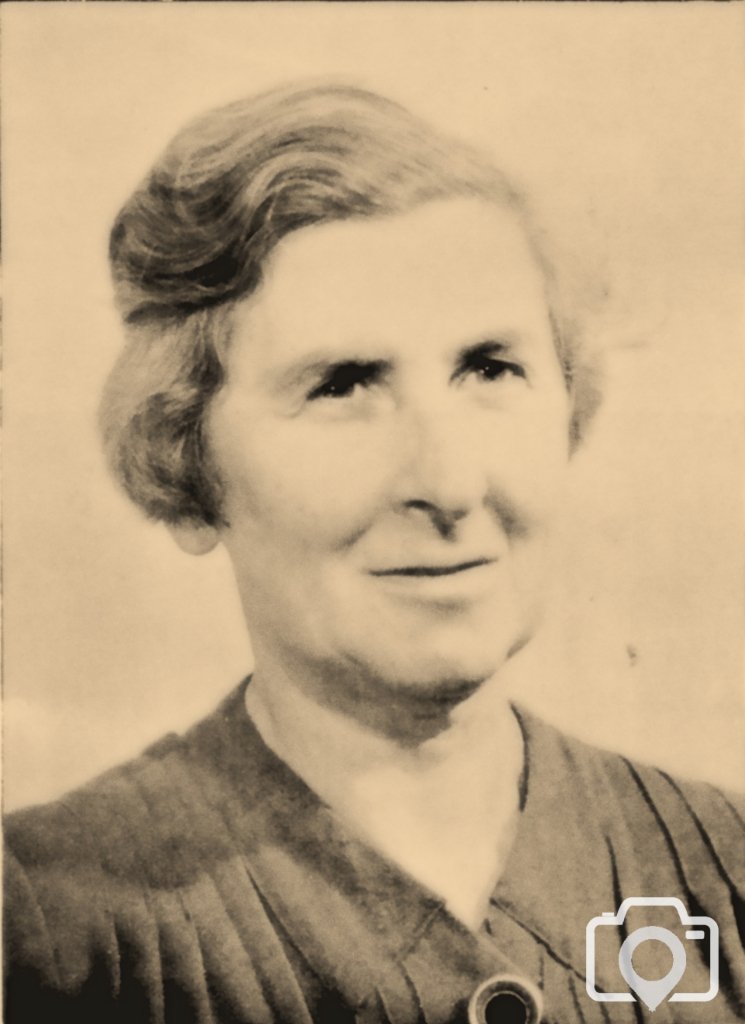THE LESCUDJACK COUNCIL SCHOOL
Written by L. W. Harvey, (Headmistress, Girls' School, 1938 - 1958) Credits Ray and Rhys Owens
I was appointed Head Mistress of Lescudjack Girls' School in September 1938. At that time, it was an all-age school, ages ranging from 7—14 years. There were five classes with 50 girls in each. The staff, at that time, were Miss C. M. Symons, Miss G. Cooke, Miss I. Coppin, Miss F. Maddern and Miss C. Phillips.
The Hall was shared by the three Schools, Boys', Girls', Infants', for Assembly, some Physical Training, lectures by visitors, for end-of- term concerts, etc. Most of the Physical Training had to be out-of-doors in a small rolling-hill playground, which was most inadequate, or in the Children's Playground where permission for its use was granted by the Borough Council.
In 1939 World War II started. We were provided with air-raid shelters, in classrooms, where it was possible to put them. Where space was inadequate, the girls had to scatter in different places, e.g., in the shed, in the playground, or outside school premises at convenient protective places. All this meant a good deal of interruption, from time to time, but the girls were always well controlled and took all as a matter of course.
In 1949 re-organization took place in the Borough and Lescudjack became a County Secondary School with ages ranging from 11—14 years. Our young ones from 7—11 were transferred to Junior Schools and we took all girls over the age of eleven. It meant quite a lot of organizing with transfer of suitable desks, books, etc. It was necessary to specialise in all subjects whereas formerly we specialised only in such subjects as Needlework and Music. Of course we needed more room and more equipment. Eventually, two new classrooms were built, sacrificing more playground space, and, after some years, a Science Block was added.
It was essential to have better opportunities for organized games, etc. A good allowance was made for equipment and a field acquired at Chapel St. Clare which was used by both schools. Arrangements were also made to make use of the Swimming Pool. One great drawback for Lescudjack was the distance from both Playing Field and Swimming Pool but full use was taken of these facilities. In the Summer Term there was usually a Folk Dance Festival and the girls always took part. Also there was a Music Festival. Miss Symons always took a choir which won a 1st class Certificate at every event. Unless memory fails me, I think they were successful eleven times and won the County Shield on at least two occasions.
After the War, some Dutch children visited Penzance and they were admitted to school for a short period. They joined in all lessons with our own girls but the language was a barrier as they knew no English and we knew no Dutch. However, they seemed to get on quite well with our girls in spite of the language difficulty.
Somewhere about 1940, a Canteen was started. Conditions were far from ideal as the building was merely a hut but the Canteen Staff made the best of the circumstances. After the war, conditions improved and dinners offered more variety.
When the school-leaving-age was raised to 15, it was not altogether generally welcomed but experience showed how successful it was. All the staff appreciated what a great improvement there was in that last year at school. Though all girls were not academically minded, there was great improvement in their general attitude, development and responsibility. More girls took advantage of the opportunity of entering for the Technical College examinations and there were many successes. Some of these girls are now qualified teachers, in offices, and in the Civil Service.
I must not omit to mention Domestic Science. The room used was a distance from school but all girls had a day or half day a week there, according to age. At Christmas, every year, an exhibition of Christmas puddings, cakes, etc., was displayed and appreciated by parents and friends who attended. The room was well equipped and every advantage taken of the facilities offered.
In the course of 20 years at the school, it is not possible to mention names of all the staff who, over the years, served short or long periods. Some left to get married or to live near their homes, or for other reasons. I will mention some in case former pupils may like to recall anyone in particular. Some who may still be on the staff, are as follows:
Miss Symons, Mrs. Cox, Miss Daniel, Mr. Kemp- sell, Miss M. Trembath, Miss E. Trembath,
Mrs. Hutch, Mrs. Green, Mrs. Lawrence, Miss Kiernan, Miss Peake, Miss Waters, Miss Thomas (Mrs. Fradd), Miss Cory, Miss Steventon, Mrs. Bradford.
The appointment of a school secretary was more than welcomed. Questions for terminal examinations could be typed or cyclostyled to the relief of the staff. As time progressed, the secretary work, under the care of Mrs. Andrewartha, greatly increased in scope and intensity, and was only possible with the help of an efficient secretary.
I feel that I must mention our end-of-term concerts which were always popular, particularly at Christmas when a Nativity Play was well produced. Also there were displays of Needlework and Art.
At Christmas, too, we held a Carol Service, at High Street Church, with the kind permission of the Church Trustees, when governors, parents and friends were invited. Mr. Watley, the organist, kindly officiated for us and we very much appreciated his services on these occasions.
I retired at the end of the Summer Term, 1958. Changes were to take place as the Boys' and Girls' Schools were to be amalgamated and in charge of the then Head Master of the Boys' School. Thus— further change—and the story of Lescudjack must be told by yet another.
Written by L. W. Harvey, (Headmistress, Girls' School, 1938 - 1958) Credits Ray and Rhys Owens
I was appointed Head Mistress of Lescudjack Girls' School in September 1938. At that time, it was an all-age school, ages ranging from 7—14 years. There were five classes with 50 girls in each. The staff, at that time, were Miss C. M. Symons, Miss G. Cooke, Miss I. Coppin, Miss F. Maddern and Miss C. Phillips.
The Hall was shared by the three Schools, Boys', Girls', Infants', for Assembly, some Physical Training, lectures by visitors, for end-of- term concerts, etc. Most of the Physical Training had to be out-of-doors in a small rolling-hill playground, which was most inadequate, or in the Children's Playground where permission for its use was granted by the Borough Council.
In 1939 World War II started. We were provided with air-raid shelters, in classrooms, where it was possible to put them. Where space was inadequate, the girls had to scatter in different places, e.g., in the shed, in the playground, or outside school premises at convenient protective places. All this meant a good deal of interruption, from time to time, but the girls were always well controlled and took all as a matter of course.
In 1949 re-organization took place in the Borough and Lescudjack became a County Secondary School with ages ranging from 11—14 years. Our young ones from 7—11 were transferred to Junior Schools and we took all girls over the age of eleven. It meant quite a lot of organizing with transfer of suitable desks, books, etc. It was necessary to specialise in all subjects whereas formerly we specialised only in such subjects as Needlework and Music. Of course we needed more room and more equipment. Eventually, two new classrooms were built, sacrificing more playground space, and, after some years, a Science Block was added.
It was essential to have better opportunities for organized games, etc. A good allowance was made for equipment and a field acquired at Chapel St. Clare which was used by both schools. Arrangements were also made to make use of the Swimming Pool. One great drawback for Lescudjack was the distance from both Playing Field and Swimming Pool but full use was taken of these facilities. In the Summer Term there was usually a Folk Dance Festival and the girls always took part. Also there was a Music Festival. Miss Symons always took a choir which won a 1st class Certificate at every event. Unless memory fails me, I think they were successful eleven times and won the County Shield on at least two occasions.
After the War, some Dutch children visited Penzance and they were admitted to school for a short period. They joined in all lessons with our own girls but the language was a barrier as they knew no English and we knew no Dutch. However, they seemed to get on quite well with our girls in spite of the language difficulty.
Somewhere about 1940, a Canteen was started. Conditions were far from ideal as the building was merely a hut but the Canteen Staff made the best of the circumstances. After the war, conditions improved and dinners offered more variety.
When the school-leaving-age was raised to 15, it was not altogether generally welcomed but experience showed how successful it was. All the staff appreciated what a great improvement there was in that last year at school. Though all girls were not academically minded, there was great improvement in their general attitude, development and responsibility. More girls took advantage of the opportunity of entering for the Technical College examinations and there were many successes. Some of these girls are now qualified teachers, in offices, and in the Civil Service.
I must not omit to mention Domestic Science. The room used was a distance from school but all girls had a day or half day a week there, according to age. At Christmas, every year, an exhibition of Christmas puddings, cakes, etc., was displayed and appreciated by parents and friends who attended. The room was well equipped and every advantage taken of the facilities offered.
In the course of 20 years at the school, it is not possible to mention names of all the staff who, over the years, served short or long periods. Some left to get married or to live near their homes, or for other reasons. I will mention some in case former pupils may like to recall anyone in particular. Some who may still be on the staff, are as follows:
Miss Symons, Mrs. Cox, Miss Daniel, Mr. Kemp- sell, Miss M. Trembath, Miss E. Trembath,
Mrs. Hutch, Mrs. Green, Mrs. Lawrence, Miss Kiernan, Miss Peake, Miss Waters, Miss Thomas (Mrs. Fradd), Miss Cory, Miss Steventon, Mrs. Bradford.
The appointment of a school secretary was more than welcomed. Questions for terminal examinations could be typed or cyclostyled to the relief of the staff. As time progressed, the secretary work, under the care of Mrs. Andrewartha, greatly increased in scope and intensity, and was only possible with the help of an efficient secretary.
I feel that I must mention our end-of-term concerts which were always popular, particularly at Christmas when a Nativity Play was well produced. Also there were displays of Needlework and Art.
At Christmas, too, we held a Carol Service, at High Street Church, with the kind permission of the Church Trustees, when governors, parents and friends were invited. Mr. Watley, the organist, kindly officiated for us and we very much appreciated his services on these occasions.
I retired at the end of the Summer Term, 1958. Changes were to take place as the Boys' and Girls' Schools were to be amalgamated and in charge of the then Head Master of the Boys' School. Thus— further change—and the story of Lescudjack must be told by yet another.
L W Harvey Headmistress
L W Harvey Headmistress of Lescudjack County Girls School 1938 - 1958
Last edited:


